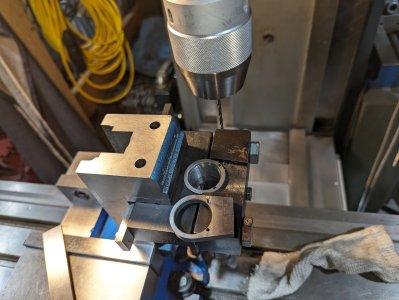-
Welcome back Guest! Did you know you can mentor other members here at H-M? If not, please check out our Relaunch of Hobby Machinist Mentoring Program!
You are using an out of date browser. It may not display this or other websites correctly.
You should upgrade or use an alternative browser.
You should upgrade or use an alternative browser.
POTD- PROJECT OF THE DAY: What Did You Make In Your Shop Today?
- Thread starter wachuko
- Start date
- Joined
- Dec 20, 2021
- Messages
- 891
Stuck with lifting restrictions for a while. So working on some back burner projects. The shop is irritatingly too hot/too cold. Been meaning to make an automated damper for some time now. Just haven't done so yet. Good excuse to play with some Arduino hardware, DS18B22 Temp sensors, some stepper drives, and the 3D printer.
The first step, was the damper design. It might be over complicated, but I'm probably only going to make 1, so who cares. Why buy for $100 what you can make for $1000 in time!
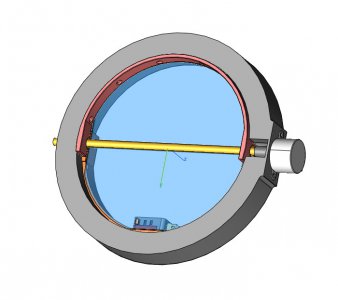
Design uses a 64:1 gear head stepper motor, and a limit (home) switch. I decided on adding the inside stoppers to cut airflow to nearly zero when this thing is off.
The idea will be to monitor the room temperature, and plenum temperature. If the room temp is too hot, and the plenum is heating, pinch off the airflow. If the room is too cold and it's heating, open it up. In the reverse situation if the room is too cold and the plenum is cooling, pinch off airflow. If the room temp is too hot, and it's cooling, let it cool.
Maybe, just maybe, I'll look at throttling the air and/or adding a PID if the temps are close. The stepper with home switch will allow that sort of complexity.
The brain are needed in the termostat because the house system may cool, or may heat, and this room isn't included in that control. I also run some fan on time to keep air filtered and circulating while neither heating or cooling. That fan only time would allow this system to adjust the room as needed when the HVAC is idle but moving air
The big carrot here, is if this works out it should stabilize the surface plate temp. While this isn't an AA plate, if it ever gets calibrated, having it in a temp controlled room would be a good start to getting it there...
Here's the results of about 24 hours of 3D printing. The outside ring is large to be stiff enough to force the 6" round into a circle. That way the yet to be made aluminum damper can be cut close and circular. I've had this roll of PETG laying around forever, so might as well burn some up!
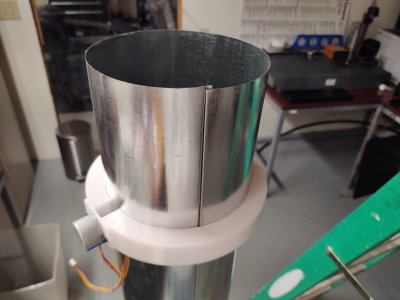
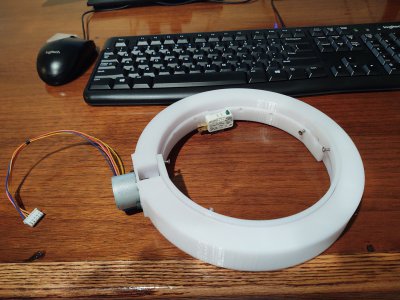
While the prints were running, managed to get the dual temp sensors and stepper motor operating. It's a ratsnest, but it working well enough.
The first step, was the damper design. It might be over complicated, but I'm probably only going to make 1, so who cares. Why buy for $100 what you can make for $1000 in time!

Design uses a 64:1 gear head stepper motor, and a limit (home) switch. I decided on adding the inside stoppers to cut airflow to nearly zero when this thing is off.
The idea will be to monitor the room temperature, and plenum temperature. If the room temp is too hot, and the plenum is heating, pinch off the airflow. If the room is too cold and it's heating, open it up. In the reverse situation if the room is too cold and the plenum is cooling, pinch off airflow. If the room temp is too hot, and it's cooling, let it cool.
Maybe, just maybe, I'll look at throttling the air and/or adding a PID if the temps are close. The stepper with home switch will allow that sort of complexity.
The brain are needed in the termostat because the house system may cool, or may heat, and this room isn't included in that control. I also run some fan on time to keep air filtered and circulating while neither heating or cooling. That fan only time would allow this system to adjust the room as needed when the HVAC is idle but moving air
The big carrot here, is if this works out it should stabilize the surface plate temp. While this isn't an AA plate, if it ever gets calibrated, having it in a temp controlled room would be a good start to getting it there...
Here's the results of about 24 hours of 3D printing. The outside ring is large to be stiff enough to force the 6" round into a circle. That way the yet to be made aluminum damper can be cut close and circular. I've had this roll of PETG laying around forever, so might as well burn some up!


While the prints were running, managed to get the dual temp sensors and stepper motor operating. It's a ratsnest, but it working well enough.
- Joined
- Nov 23, 2014
- Messages
- 2,609
POTD was fixing the Y-axis crank handle on my Bridgeport. My BP has a circa-1981 Anilam Crusader II 2-axis CNC setup, the rapids are 100 ipm making a standard crank handle a real safety problem when running a CNC routine. Fortunately, my BP has safety handles. The crank handle is spring-loaded to keep it tucked inside the handle hub. That is, until the spring breaks . . .
Alas, no little blue pill for the safety handle
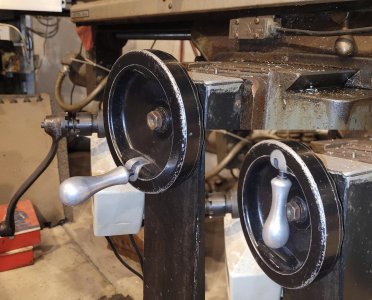
There’s a detail with the crank and torsion spring that’s pressed into the handle hub. The handle has an axle with a cross-slot to capture one end of a torsion spring. The mounting block for the crank handle also has a slot cut to capture the opposite end of the torsion spring. The torsion spring is rotated with the handle tucked into the hub to give some preload; pulling the crank away from the hub rotates the spring tighter; the crank snaps back into the hub when released.
I tapped out the crank detail with a punch, pulled and measured the spring. Next step was turning a mandrel for wrapping the spring. Machinery’s Handbook has a page of mandrel sizes: the variables are the spring’s coil diameter and the wire diameter. Chucked up a piece of 5/16” CRS and turned to 0.300” which “should” form a spring of (approximately) OD 0.410”.
The torsion spring has a tail that runs across the inside of the coil. I figured the best way to do this was to pre-bend a 90 in the music wire and slip the “tail” into a slot cut in the mandrel. My plan was to cut the slot in the mandrel on the DoAll bandsaw. I was a little worried about the side load from 0.041” music wire being wrapped around a cantilevered mandrel; turned a cap/bushing of sorts to fit over the end of the mandrel. This would let me wind the spring between centers.
Tapped out the crank detail. The torsion spring "should" have a leg that goes through the slot in the round detail. That detail attaches to the crank; rotates with the crank.
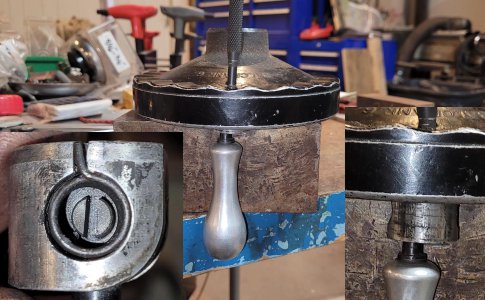
Machinery's Handbook lists springs in 3/8" and 7/16" OD; mine was a tweener.
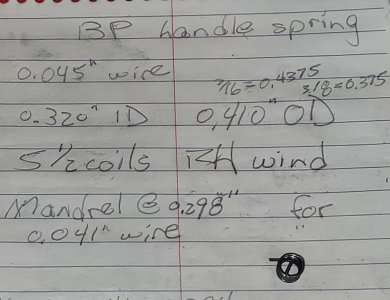
Made a cap/bushing to slip over the end of the mandrel. I was worried about bending the mandrel with the forces needed to wind 0.041" music wire around the mandrel. Faced, center drilled one side for the tail stock center. Flipped, faced, center drilled and drilled a hole at the mandrel OD; mandrel end will slide into the hole. This let me wind the spring between centers.
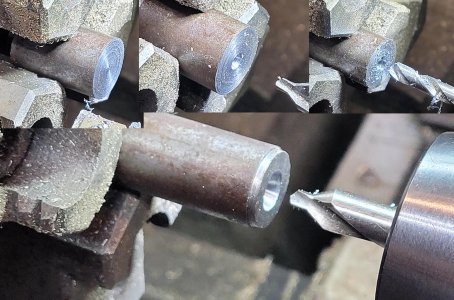
Turned the mandrel on the lathe. Inserted into the support cap, marked depth and bandsawed a slot for the tail of the spring.
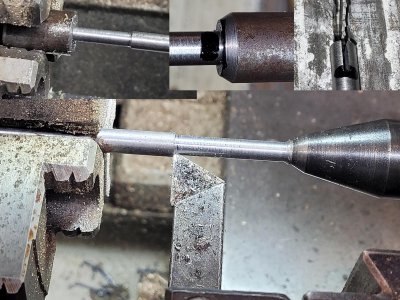
Winding was done using a spring-winding jig I made months ago. I first did a 90-degree bend in the music wire with a pliers, then fed the wire into the slot of the mandrel. Slipped the end cap on the mandrel and engaged the tailstock center for added support. Winding was done by manually rotating the chuck and moving the carriage. The original spring had 5 ½ winds; when winding a spring you have to go longer as the coil springs back (pun intended) when cut.
Bend the end of the music wire to a 90 and slip it in the slot at the end of the mandrel. Then slip on the end plug/bushing and engage the tailstock center
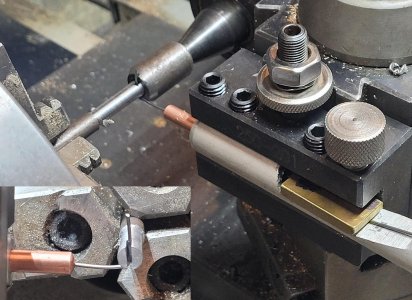
I “winged it” and did 7 turns, cut the wire and ended up with less than 5 coils. I measured the OD at ~0.450” which was too big to fit into the detail for the crank. Well, the mandrel was still on the lathe, swapped to a turning tool and took 0.040” off the mandrel. Why the error? I checked my math again from Machinery’s Handbook which was correct. All I can think is I might not have had the wire centered in my winding jig so the clamp pressure was lacking (?). On the other hand, the coils were tight to the mandrel; another unsolved shop mystery.
For the second go-around, the coil measured 0.400” on the OD or 0.010” under my target but it would work. I found winding 7 ½ coils gave me about 6 full coils after cutting the music wire.
Wound the spring by manually rotating the chuck, count coils and cut with a side cutters
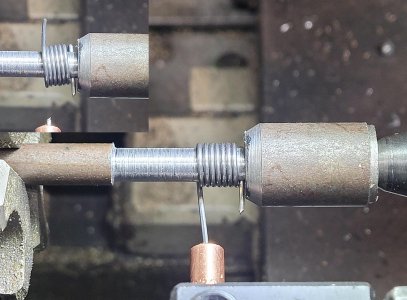
Back off the tail stock, pull the end cap/bushing and slide the spring off the mandrel
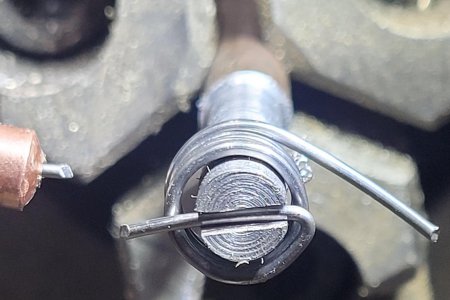
I didn’t show it, but the “outie” leg was bent with pliers. I held the coil with a pair of needle-nose at the radial point for the kick-out and bent the leg with another pair of pliers. Side cutters to trim to length. Installation to the crank detail is pretty simple; drop the spring in, slip the cross-leg into the handle slot, rotate the spring a half-turn for some preload, and slip the “outie” leg in the detail’s slot.
My spring on the left, original on the right. Spring ends were cut to length after the fact with side cutters
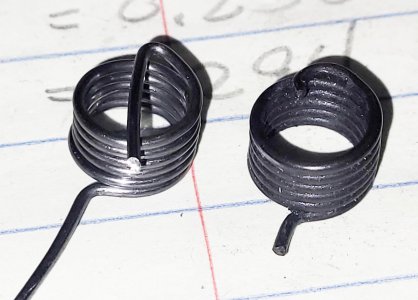
The second go-around worked great. The crank stays in its safe position even at a 100 ipm rapid. Pulls out with minimal effort and snaps back into “safe mode” when released.
Slipped the spring into the detail; inside-coil cross leg goes into the crank handle detail slot. Rotate the spring at the "outie" end with pliers to get some pre-load, slip the tail into the detail's slot and voila!
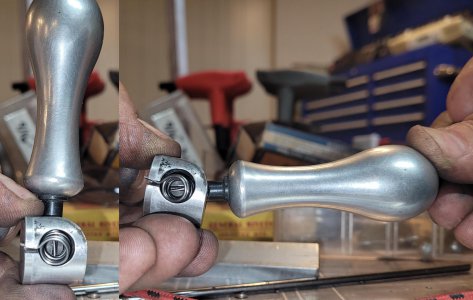
Tapped the crank detail (it has a light press fit) back into the hub with a leather hammer
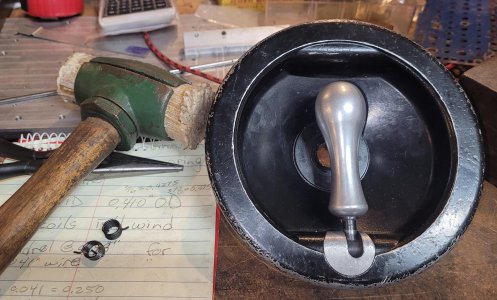
Looking good!
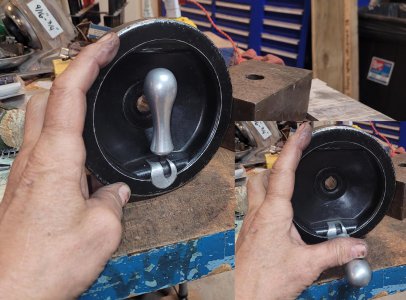
No more dodging the crank handle when running a routine!
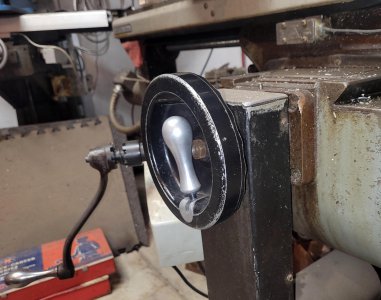
As long as I had the setup on the lathe, figured I might as well make a 4x lifetime supply of springs!
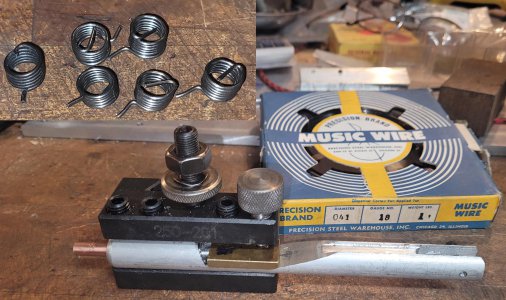
Thanks for looking, Bruce
p.s. In the thinking about it more than I should category, I wondered about calculating the number of wound coils vs. finished coils. My OD while winding was 0.34” for a circumference of 1.068”. Going 7 ½ turns should use about 7 ¾” of wire.
My finished spring had an OD of ~0.400” for a circumference of 1 ¼”; 5 ½ turns is ~7” of wire. The math did work out pretty closely as my rough-cut spring needed to be unwound about 1/2 turn to get to the 5 ½ coil point.
Alas, no little blue pill for the safety handle

There’s a detail with the crank and torsion spring that’s pressed into the handle hub. The handle has an axle with a cross-slot to capture one end of a torsion spring. The mounting block for the crank handle also has a slot cut to capture the opposite end of the torsion spring. The torsion spring is rotated with the handle tucked into the hub to give some preload; pulling the crank away from the hub rotates the spring tighter; the crank snaps back into the hub when released.
I tapped out the crank detail with a punch, pulled and measured the spring. Next step was turning a mandrel for wrapping the spring. Machinery’s Handbook has a page of mandrel sizes: the variables are the spring’s coil diameter and the wire diameter. Chucked up a piece of 5/16” CRS and turned to 0.300” which “should” form a spring of (approximately) OD 0.410”.
The torsion spring has a tail that runs across the inside of the coil. I figured the best way to do this was to pre-bend a 90 in the music wire and slip the “tail” into a slot cut in the mandrel. My plan was to cut the slot in the mandrel on the DoAll bandsaw. I was a little worried about the side load from 0.041” music wire being wrapped around a cantilevered mandrel; turned a cap/bushing of sorts to fit over the end of the mandrel. This would let me wind the spring between centers.
Tapped out the crank detail. The torsion spring "should" have a leg that goes through the slot in the round detail. That detail attaches to the crank; rotates with the crank.

Machinery's Handbook lists springs in 3/8" and 7/16" OD; mine was a tweener.

Made a cap/bushing to slip over the end of the mandrel. I was worried about bending the mandrel with the forces needed to wind 0.041" music wire around the mandrel. Faced, center drilled one side for the tail stock center. Flipped, faced, center drilled and drilled a hole at the mandrel OD; mandrel end will slide into the hole. This let me wind the spring between centers.

Turned the mandrel on the lathe. Inserted into the support cap, marked depth and bandsawed a slot for the tail of the spring.

Winding was done using a spring-winding jig I made months ago. I first did a 90-degree bend in the music wire with a pliers, then fed the wire into the slot of the mandrel. Slipped the end cap on the mandrel and engaged the tailstock center for added support. Winding was done by manually rotating the chuck and moving the carriage. The original spring had 5 ½ winds; when winding a spring you have to go longer as the coil springs back (pun intended) when cut.
Bend the end of the music wire to a 90 and slip it in the slot at the end of the mandrel. Then slip on the end plug/bushing and engage the tailstock center

I “winged it” and did 7 turns, cut the wire and ended up with less than 5 coils. I measured the OD at ~0.450” which was too big to fit into the detail for the crank. Well, the mandrel was still on the lathe, swapped to a turning tool and took 0.040” off the mandrel. Why the error? I checked my math again from Machinery’s Handbook which was correct. All I can think is I might not have had the wire centered in my winding jig so the clamp pressure was lacking (?). On the other hand, the coils were tight to the mandrel; another unsolved shop mystery.
For the second go-around, the coil measured 0.400” on the OD or 0.010” under my target but it would work. I found winding 7 ½ coils gave me about 6 full coils after cutting the music wire.
Wound the spring by manually rotating the chuck, count coils and cut with a side cutters

Back off the tail stock, pull the end cap/bushing and slide the spring off the mandrel

I didn’t show it, but the “outie” leg was bent with pliers. I held the coil with a pair of needle-nose at the radial point for the kick-out and bent the leg with another pair of pliers. Side cutters to trim to length. Installation to the crank detail is pretty simple; drop the spring in, slip the cross-leg into the handle slot, rotate the spring a half-turn for some preload, and slip the “outie” leg in the detail’s slot.
My spring on the left, original on the right. Spring ends were cut to length after the fact with side cutters

The second go-around worked great. The crank stays in its safe position even at a 100 ipm rapid. Pulls out with minimal effort and snaps back into “safe mode” when released.
Slipped the spring into the detail; inside-coil cross leg goes into the crank handle detail slot. Rotate the spring at the "outie" end with pliers to get some pre-load, slip the tail into the detail's slot and voila!

Tapped the crank detail (it has a light press fit) back into the hub with a leather hammer

Looking good!

No more dodging the crank handle when running a routine!

As long as I had the setup on the lathe, figured I might as well make a 4x lifetime supply of springs!

Thanks for looking, Bruce
p.s. In the thinking about it more than I should category, I wondered about calculating the number of wound coils vs. finished coils. My OD while winding was 0.34” for a circumference of 1.068”. Going 7 ½ turns should use about 7 ¾” of wire.
My finished spring had an OD of ~0.400” for a circumference of 1 ¼”; 5 ½ turns is ~7” of wire. The math did work out pretty closely as my rough-cut spring needed to be unwound about 1/2 turn to get to the 5 ½ coil point.
- Joined
- Mar 22, 2022
- Messages
- 345
Been avoiding pulling off the external bits of the headstock such as the spindle pully and gear hub in fear running into a stuck part.
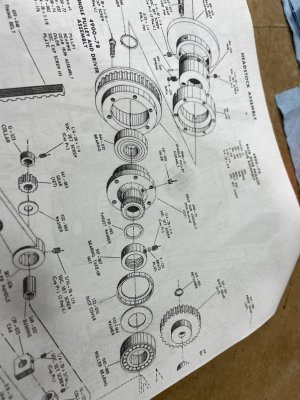
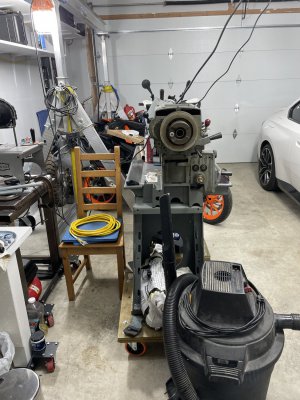
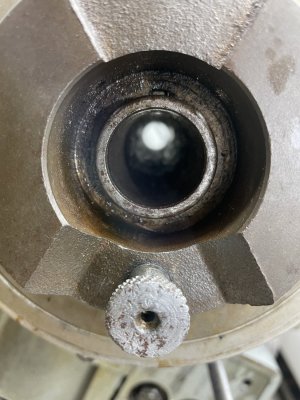
Back gear hub assembly is inset into the spindle pulley, hub is keyed to the spindle and shows some old lubricant which is encouraging.
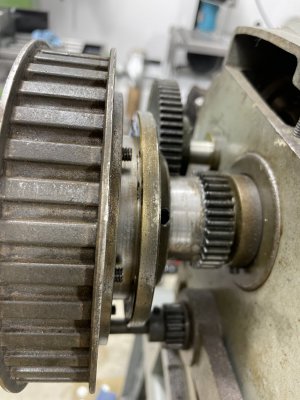
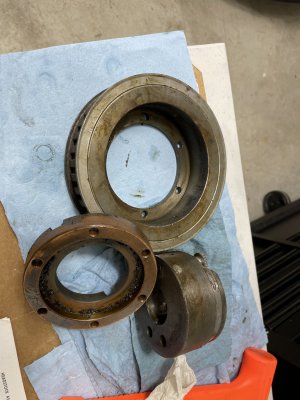 Some minor taps with a small dead blow and came apart without much fuss.
Some minor taps with a small dead blow and came apart without much fuss.
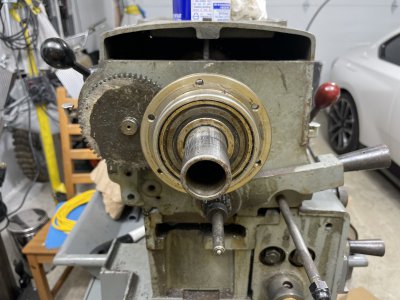
Pulley bearing is in good shape so thumbs up on that one.



Back gear hub assembly is inset into the spindle pulley, hub is keyed to the spindle and shows some old lubricant which is encouraging.

 Some minor taps with a small dead blow and came apart without much fuss.
Some minor taps with a small dead blow and came apart without much fuss.
Pulley bearing is in good shape so thumbs up on that one.
- Joined
- Apr 23, 2018
- Messages
- 6,599
Been avoiding pulling off the external bits of the headstock such as the spindle pully and gear hub in fear running into a stuck part.
Nothing to fear! Glad it came apart. The folks that designed those lathes were pretty smart.
- Joined
- Apr 23, 2018
- Messages
- 6,599
Looks good John. such an unglamorous/unseen part but absolutely critical in the quest for the holy grailNever again will I use two-pin recoil lugs. One pin is hard enough to drill straight, two is ridiculous, and three is right out.
View attachment 463860
- Joined
- Nov 24, 2014
- Messages
- 3,195
Never again will I use two-pin recoil lugs. One pin is hard enough to drill straight, two is ridiculous, and three is right out.
Suggestion (for next time?).
Make a male threaded screw that holds the lug to the receiver (like the barrel would).
Pre-drill pin holes in the lug .010-.015" diameter undersize.
Mount lug to the receiver.
Match drill and ream one hole complete.
Install that pin.
Repeat as required.
- Joined
- Dec 18, 2022
- Messages
- 1,832
Wow, is that a vise holding a vise holding a clamp?Never again will I use two-pin recoil lugs. One pin is hard enough to drill straight, two is ridiculous, and three is right out.
View attachment 463860
- Joined
- Aug 6, 2015
- Messages
- 3,905
This is how I am working these small projects... I really need that detached garaged finished soon... still 6 more before the builder gets to mine...
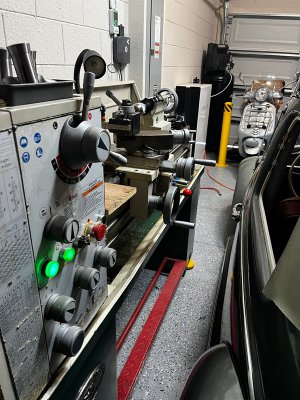
Needed to reduce the diameter of the heads so the bolts would reach the bottom... turns out that the parting tool was perfect for the width. All that I needed to remove was very little...
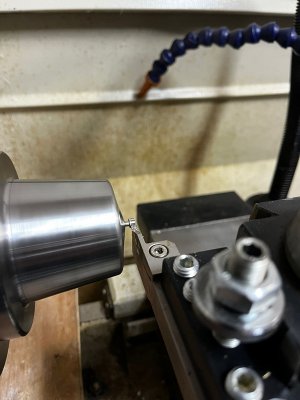
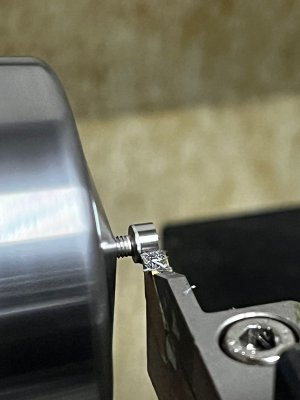
I really like working with collets...
All done and installed.
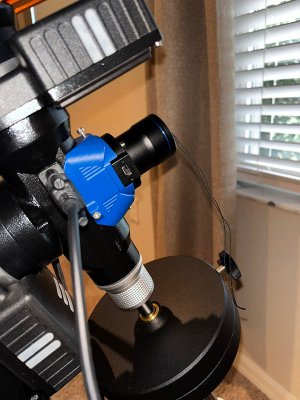
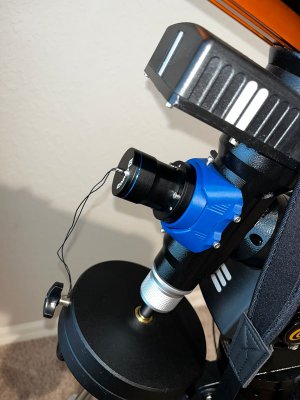
Change "water" for "garage"...

Needed to reduce the diameter of the heads so the bolts would reach the bottom... turns out that the parting tool was perfect for the width. All that I needed to remove was very little...


I really like working with collets...
All done and installed.


Change "water" for "garage"...
Last edited:


